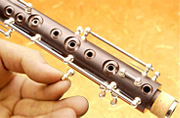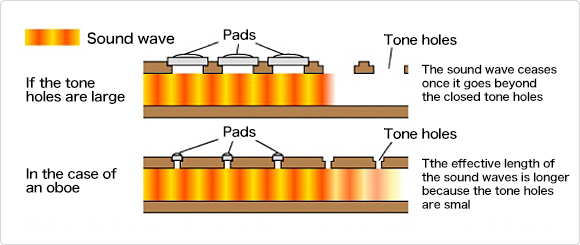How the Oboe is Made
The sound is adjusted based on the shape of the tone hole?
The smallest tone holes have diameters of 2 mm!
The photograph depicts the round-ended key posts and rods being affixed after the tone holes have been drilled. Although the tone holes take many forms, overall, they tend to be small. The smallest tone hole has a diameter of only 2 mm. These small tone holes are characteristic of instruments such as the oboe and the bassoon.

An oboe with the key posts and rods affixed. The hand is holding a key post.
The unique tones that come from tiny tone holes
Sound pressure builds up inside the pipe when sounds are produced. If the tone holes were as large as those on a flute or saxophone, there would be plenty of escape routes for the sound pressure, so the sound pressure would completely dissipate as soon as flow reached an open pad. Because the oboe's tone holes are small, however, the effective length of the sound waves stretches all the way to the end of the instrument. This somewhat irregular aspect of the oboe gives it its unique tone.

The size of tone holes and sound waves.
What is the chambering inside the tone holes for?
The areas surrounding oboe tone holes are chambered. The body of the oboe is thick, so if the tone holes were simply drilled in straight, they would be like long, narrow chimneys, which would make the sound sometimes too muffled. To fix this, the chambering makes the hole progressively broader, letting the sound escape.

Cross-sections of tone holes. The appropriate chambering for each tone hole has been added.
Undercutting changes the sound!
In addition to adding chambering, the construction of tone holes includes shaving the spots where the funnel of the hole and the bore of the pipe connect. This is called undercutting.
How the undercutting is shaved affects the timbre. The more is shaved away, the higher-pitched and brighter the tone. However, if even 0.1 mm too much is shaved off, there is a danger that the sound will be flat and hollow.

Left: With a great deal removed Right: With a little removed
An oboe's timbre and pitch would still be unstable if holes were merely added. The depth of the chambering and the amount of undercutting adjusts the clarity of each note and the resistance felt by the player when playing, making the music sound smoother when scales and melodies are played.
Musical Instrument Guide:Oboe Contents
Structure
How to Play
How the Instrument is Made
Choosing an Instrument
Trivia
- Why does the oboe lead the orchestra in tuning?
- Do the reeds have a front and a back?
- The keys recoil via springs!
- This is how the oboe and the cor anglais differ
- The charumera was the oboe's cousin
- You can reduce time spent breathing using circular-breathing techniques?
- The Wiener oboe that survived an existential crisis
- Oboe masterpieces: concertos
- Oboe masterpieces: chamber music
- What is the alto oboe?
- The heckelphone, which resembles the oboe
- The oboe is the bassoon's cousin
